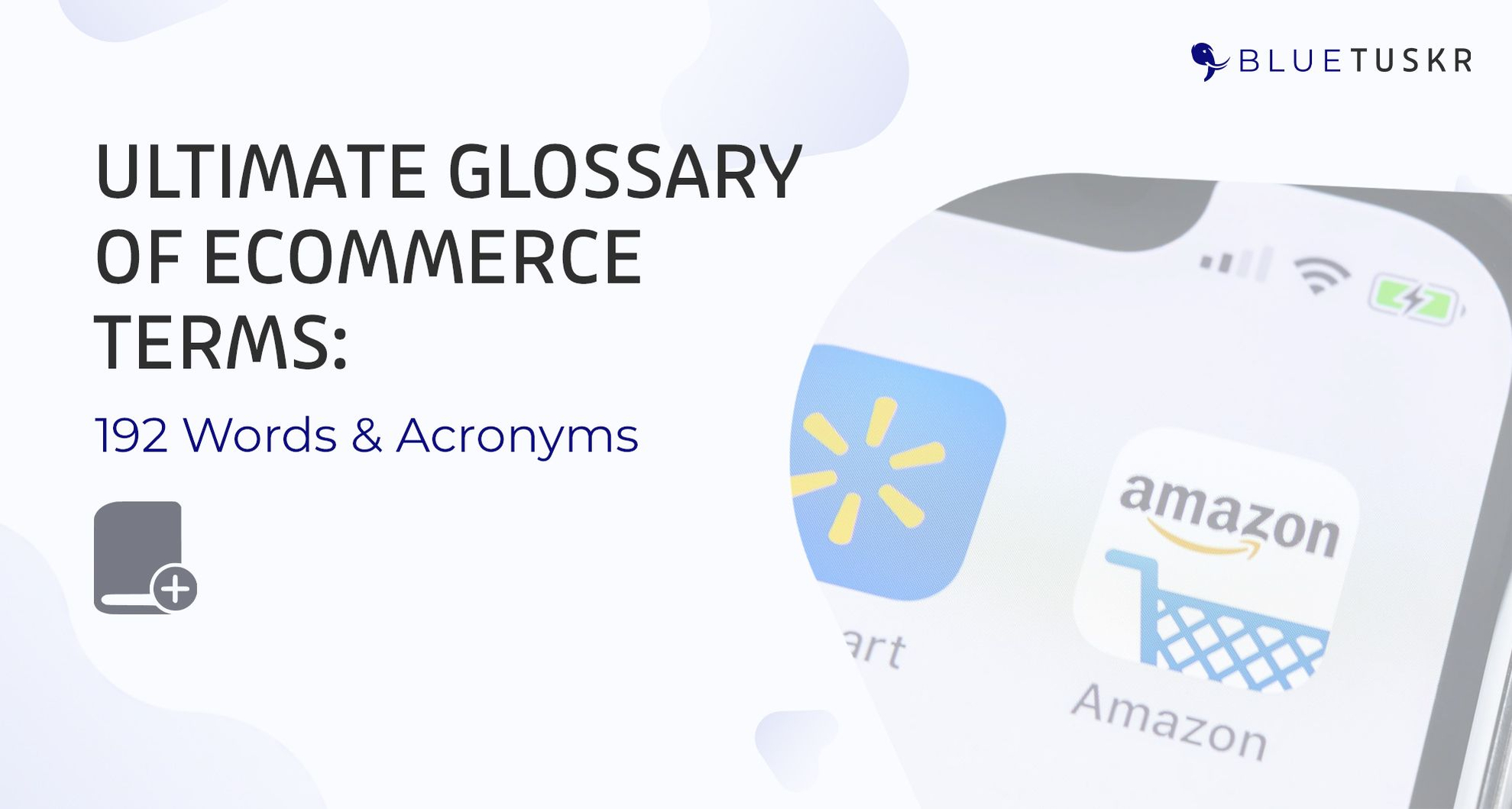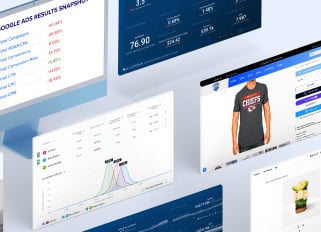
Ultimate Glossary of E-commerce Terms: 192 Words & Acronyms
The world of e-commerce is vast. As with most large communities, a type of shorthand ultimately developed. Sellers, vendors, suppliers, and service providers essentially created their own language, brimming with e-commerce terms and acronyms that aren’t part of the common lexicon.
If you’re new to e-commerce, terms like “kitting” or acronyms like “COGS” may solicit no more than a raised eyebrow. You may have no idea what they mean, and asking during the course of business might not feel like a reasonable option.
Luckily, it’s possible to improve your knowledge. By exploring the various e-commerce terms and getting to know them, you can start chatting about your experience or needs as a seller like an expert.

What Are E-commerce Terms and Acronyms?
E-commerce terms and acronyms are language elements that relate strongly to the e-commerce space. In some cases, the phrases aren’t used much beyond the seller, vendor, supplier, or service provider landscape. However, some may extend into other sectors. At times, particularly with acronyms or initialisms, the terms may even have different meanings in other industries or circles.
The acronym concept is relatively new, becoming part of common language around 1940. An acronym, according to Merriam-Webster, is “a word formed from the initial letter or letters of each of the successive parts of major parts of a compound term.” While that sounds complex, it really isn’t. For example, instead of saying “self-contained underwater breathing apparatus,” we say “scuba.”
Now, this is different from an initialism, a type of term often confused with acronyms. With initialisms, you say the actual letters instead of creating a word. For example, “FBI” and “DNA” are initialisms.
Some e-commerce terms and acronyms can be platform-specific. For example, there are Amazon seller acronyms that focus on that marketplace, specifically. However, some Amazon seller terms are also widely used, making them applicable to any seller, regardless of platform, or even beyond the e-commerce space.
The Ultimate Glossary of E-commerce Terms and Acronyms
# A B C D E F G H I J K L M N O P Q R S T U V W X Y Z
#
1. 3D Photography
Three-dimensional imagery that gives viewers the ability to rotate, zoom, or navigate around the picture. When used for products, it creates an opportunity to examine an item from every angle, as well as up close and from a distance.
2. 360-Degree Photography
See 3D Photography.
3. 3PL
3PL stands for “third-party logistics.” It covers any business that offers warehousing or fulfillment capabilities as a service, as in “3PL provider,” giving sellers the ability to outsource their storage, shipping, and similar needs.
A
4. A/B Testing
Also known as split testing, A/B testing involves presenting to versions of something, such as a marketing campaign or product images, to different consumers. The goal is to determine which version resonates strongest or boosts sales more significantly.
5. ACoS
ACoS stands for “advertising cost of sale,” and reflect the percentage of attributed sales that sellers spend on advertising. It’s metric frequently used to assess the performance of Amazon Sponsored Product, Amazon Lightning Deals, e-commerce email marketing, or similar campaigns.
6. Acquisition Marketing
Marketing efforts focused on bringing in new customers by bringing them into or moving them further down into the sales funnel.
7. Affiliate Marketing
A marketing arrangement where a company pays a commission to a third-party (affiliate) whenever that third-party’s effort generates a sale. The method is performance-based, with payments only issued to affiliates when it is known that their efforts resulted in a sale.
8. Amazon Vendor (1P)
An arrangement where Amazon is the retailer, and the seller functions as a wholesale supplier. Essentially, Amazon purchases the items directly from the seller or manufacturer, usually at a discounted rate. Amazon then sells the products to the consumer.
9. AMS
AMS stands for “Amazon marketing services.” AMS includes all built-in, platform-specific marketing programs available to various sellers, such as Sponsored Product campaigns.
10. AOV
AOV stands for “average order value.” It is a metric created by dividing total revenue by the number of orders used to generate that revenue.
11. ASIN
ASIN stands for “Amazon Standard Identification Number.” It is a unique 10-character string used to identify a specific product sold on the Amazon platform.
12. ASP
ASP stands for “average selling price,” and is a reflection of the average price a product sells for across all platforms or distribution channels.
13. ATC Rate
The ATC rate is the add-to-cart rate. This metric is a percentage, showing how many visitors or customers place a specific item in their cart.
14. ATV
ATV stands for “average transaction value.” It’s a dollar amount that shows the average amount a customer spends in a single purchase.
15. AWS
AWS stands for “Amazon Web Services,” the cloud computing platform.
B
16. B2B
B2B stands for “business-to-business,” and is used to describe transactions between two companies, instead of sales to consumers.
17. B2C
B2C stands for “business-to-consumer,” and is used to describe transactions between a seller and a consumer.
18. BFCM
BFCM stands for “Black Friday Cyber Monday,” and is used in conversations surrounding those major selling events.
19. BNPL
BNPL stands for “buy now, pay later.” With a BNPL arrangement, the customer receives the item immediately, but doesn’t have to start paying for it on the purchase day. Instead, there is a delay until payment is either due in-full or the first installment payment has to be made.
20. BOGO
BOGO stands for “buy one, get one.” It’s a promotional deal that allows customers to get access to a deal or discount after the pay for an item at full price. For example, it could be buy one, get one free, or buy one, get on half-off.
21. BOPIS
BOPIS stands for “buy online, pick-up in-store.” It’s a fulfillment that allows customers to make an online purchase but get the item from a brick-and-mortar store.
22. Bottom of the Funnel
The bottom of the funnel is a position in the sales funnel. It’s the phase where the customer is in the final part of the process, usually at the actual transaction or purchase phase.
23. Bottom-line Growth
A company’s bottom-line is a reference to its net income, as it is usually the “bottom” number on income statements. Bottom-line growth discusses increases in net income.
24. Brand Management
The act of actively taking steps to impact consumer perception of a brand, increasing the odds that consumers will view the brand’s value or position in a desired manner.
25. Brand Marketing
A marketing approach focused on the brand as a whole and not individual items.
26. Brick-and-Mortar
A descriptor used when talking about physical stores.
27. Bundling
The process of grouping a set of products together as a sales technique. Usually, it involves giving customers a discount. Instead of charging the full, total retail rate based on the items in the group, the customer pays less, but only if they purchase everything, or a specific number of items, represented in the set.
28. Buy Box
The spot on the Amazon product page where customers can add an item to their cart.
29. Buyers Persona
A mock persona designed to represent the prospective or target customer. Usually, it’s created by compiling data about existing customers, allowing the seller to estimate who their average or target seller is, including based on behavioral patterns, demographics, and more.
C
30. CAC
CAC stands for “customer acquisition cost.” It’s a metric that reflects the average amount a seller must spend on marketing to acquire a single new customer.
31. Cart Abandonment
The term for the act of adding items to an online cart, but instead of going through with the purchase, choosing the exit the site instead.
32. Category Page
A landing page on a website that list the available product categories instead of products.
33. Chargeback
The reversal of a credit card transaction where the customer receives their money back. Usually, chargebacks are caused by customer’s disputing a purchase, causing the merchant to refund the amount.
34. Churn Rate
Also called attrition rate, it’s a percentage of customers who stop doing business with a company. It’s commonly used when discussing subscription models, allowing sellers to analyze the number of customers who cancel in comparison to the total number of subscribers during a specific period.
35. Clickstream
A description of the journey a customer takes, usually through a website. It can include how they arrived at the site, the pages they advanced to, and other steps taken before making a purchase.
36. Closed-Loop Marketing
An approach for assessing the effectiveness of marketing campaigns. The method is highly data-driven, and usually involves multi-channel analysis, including data from a seller’s website, blog traffic, SEO efforts, email marketing, and more.
37. CMS
CMS stands for “content management system,” technology used to create, publish, edit, and manage a range of website content, including landing pages, blogs posts, and more.
38. COGS
COGS stands for “cost of goods sold,” a metric that showcases the total costs associated with a particularly product. It can include manufacturing, packaging, shipping, taxes, listing fees, and a range of other associated expenses.
39. Cohort Analysis
The process of analyzing the behavior of a specific customer subset, usually based on a specific attribute or attribute set.
40. Consumer Insights
Information about a seller’s current or prospective customers, usually generated by gathering data from a range of sources.
41. Consumer Touchpoints
Tools that allow consumers to engage with a company, such as websites, smartphone apps, physical stores, messengers, chatbots, phone numbers, and more.
42. Content
Text, images, videos, and audio that visitors encounter when on a website.
43. Content Marketing
A marketing approach that focuses on sharing text, images, video, or audio that doesn’t promote the brand or a product specifically, but instead drives interests or develops the brand’s identity.
44. Conversational Commerce
An e-commerce approach where transactions are conducted or information is shared through dialogs, usually facilitated by live reps, chatbots, or AI assistant technology.
45. Conversion
When a person exposed to a marketing attempt takes a desired action.
46. Conversion Funnel
The process that has to be followed to take to reach a specific goal, like the checkout pages a customer must navigate to make a purchase.
47. Conversion Path
The steps required to get shift an anonymous potential buyer into a qualified lead, typically those between the visitor arriving at a site and ultimately making or abandoning a purchase.
48. Conversion Rate
The percentage of prospective customers who ultimately take the desired action.
49. Cookies
Small text files that note a website visitor’s actions while browsing that are often used for ad targeting.
50. COTS
COTS stands for “commercial off the shelf,” and typically refers to software packages that is ready-made for use.
51. CPA
CPA stands for “cost per acquisition,” a metric reflecting the cost of acquiring a single paying customer using a particular marketing campaign or conversion channel.
52. CPC
CPC stands for “cost per click,” the amount you pay every time a person clicks on a pay-per-click ad.
53. CPG
CPG stands for “consumer packaged goods,” a term that covers products that the typical consumer uses daily or frequently, and requires regular replenishment or replacement.
54. CPL
CPL stands for “cost per lead,” a pricing model for digital marketing that involves a set price for every lead generation.
55. CPM
CPM stands for “cost per mille,” a reference to the price for displaying an ad 1,000 times, resulting in 1,000 impressions.
56. CRAP
CRAP stands for “can’t realize a profit,” referencing an item that isn’t generating profit for a reason.
57. CRM
CRM stands for “customer relationship management” and refers to software designed to enhance and track customer interactions with the goal of improving processes and driving profitability.
58. CRO
CRO stands for “conversion rate optimization,” the process of adjusting the website visitor experience to increase the chances of conversion.
59. Cross-sells
Presenting customers with similar or aligned items – based on their current cart or past purchases – to drive sales.
60. CTA
CTA stands for “call-to-action” and references any request for the customer to do a particular task, like sign up for a newsletter, make a purchase, or ask for more information about a product.
61. CTLV or CLV
CTLV and CLV both stand for “customer lifetime value,” a metric that reflects the amount an average customer is likely to spend, over the course of their entire lifespan, on your products or services.
62. CTOR
CTOR stands for “click-to-open rate,” a metric that showcases the number of email marketing message recipients that click the email to learn more.
63. CTR
CTR stands for “click through rate,” a ratio or percentage noting how many website visitors, email recipients, or individuals who have seen an add actually click to learn more.
64. Customer Experience (CX)
The perceived quality of the interactions a customer has with your business.
65. Customer Journey
A term that covers the phases a customer moves through, starting with initial awareness of a product or business and ending with a purchase.
66. Customer Loyalty
A reflection of how likely a customer is to return to your business and make additional purchases.
D
67. Digital Assets
Anything used to represent your company online, like logos, product photographs, custom fonts, brand guides, mission statements, value statements, landing page content, and more.
68. Digital Shelf
The location of a product listing on a retail website, shopping app, third-party marketplace, etc., specifically in reference to the customer browsing experience.
69. Direct Traffic
Website traffic generated by the visitor typing your site’s URL into the browser, or accessing your store’s website link through a saved bookmark.
70. Display Advertising
Clickable paid online ads that display on websites, such as banner ads, usually featuring an image and text.
71. Distributed Commerce
An e-commerce mechanism that allows customers to make purchases from another source without having the leave the website or platform they are viewing, such as shoppable social media ads.
72. Dropshipping
Dropshipping is an e-commerce seller approach where the seller doesn’t maintain any physical inventory, instead partnering with a supplier who handles product storage and shipping to customers.
73. DTC
DTC stands for “direct-to-consumer,” referencing brands that sell straight to the end-user without going through a retailer, wholesaler, or distributor.
E
74. E-commerce Platform
A software solution that provides sellers with critical e-commerce tools, such as shopping cart functionality, as well as operation management benefits. This is the tool you use to start your e-commerce business.
75. Email Marketing
An advertising approach focused on promoting products or services with email messages, usually focusing on visitors or customers who’ve expressed interest in such material, like those who actively signed up for a newsletter or sales notices.
76. Engagement Rate
A metric reflecting the number or percentage of visitors, ad viewers, or other groups interacting with digital content or an ad.
77. ESP
ESP stands for “email service provider,” referencing email marketing solutions like Klaviyo and Mailchimp.
78. Event-Triggered Email
When email list subscribers receive a message in conjunction with a particular event, like a birthday, anniversary, or similar moment.
F
79. FBA
FBA stands for “Fulfillment by Amazon,” an e-commerce fulfillment center option for selling products on Amazon, typically giving sellers the ability to make their items Prime eligible.
80. Flash Sale
A promotion or discount that’s only available for a very short period, such as one day or only several hours.
81. FMCG
FMCG stands for “fast-moving consumer goods,” a reference to products that sell quickly, typically at lower price points.
82. Fulfillment
The process of getting an online order to a customer, usually involving processing, picking, packing, and shipping.
G
83. Geo-targeting
An advertising approach that displays specific ads to people in a particular geographic region, such as a country, state, or city.
84. Google Ads
An advertising service operated by Google.
85. Google Analytics
A tool that analyzes website traffic, providing the site owner with insights about the website’s visitors.
86. Growth Hacking
An approach to marketing that aims to spur fast growth, either by spurring a large number of sales or significantly boosting visibility. This method usually involves the use of several data sources and marketing techniques.
87. GWP
GWP stands for “gift with purchase,” referencing any transaction where the buyer gets something extra in conjunction with a purchase. Usually, the triggering purchase involves are larger or higher-priced item, and the GWP is typically small and low-cost, such as the product samples usually given out in the beauty or food industries.
I
88. Impressions
A metric noting the number of times an ad, image, or post has been presented to a website visitor, social media app user, etc.
89. Inbound Link
Links on a third-party website that point to your site.
90. Inbound Marketing
A content and social media marketing approach that aims to boost credibility by getting the seller’s website links posted on other sites.
91. Influencer Marketing
A marketing strategy that involves partnering with an “influencer” – a person with clout in a particular, relevant niche – to reach a target audience, boost visibility, and/or generate sales.
92. Inventory
Product that is on-hand and available for immediate shipment/sale.
K
93. Kitting
Bringing together several products or items to be sold as a group or set, ensuring that the bundle is ready-to-ship, reducing the packing burden when the kit is purchased and expediting fulfillment.
94. KPI
KPI stands for “key performance indicator,” a blanket term for performance-oriented metrics that are highly relevant to the business’s or seller’s objectives.
L
95. Landing Page
The individual webpage where a user enters a website after clicking a link.
96. Lookalike Audience
A group of people who share characteristics with your customers, either in-full or in-part.
M
97. MAP
MAP stands for “minimum advertised price,” a dollar amount that is the lowest a retailer can sell an advertise an item for, according to the manufacturer. If the retailer sells the product for less than that amount, it cannot display the price in print or online. For online purchases, the price isn’t shown to the customer until the item is in their shopping cart.
98. Margin
A metric – usually written as a percentage – that compares the cost of product acquisition to the sales price.
99. Marketing Automation
Using software to automate marketing functions, like displaying posts on social media, sending emails to newsletter members, or launching an online ad campaign.
100. Merchant
The company or individual selling a product or service.
101. Micro-Fulfillment
A fulfillment approach that focuses on expediting the speed of delivery to customers, relying on small-scale warehouses that are usually placed near to population centers.
102. Mobile Commerce
E-commerce approach that supports customers buying from a site using a mobile device, such as a smartphone.
103. Mobile Marketing
An advertising method that focuses on ad delivery to mobile devices.
104. MoR
MOR stands for “minimum order requirement,” the minimum a person or business must purchase for the order to go through.
105. MRR
MRR stands for “monthly recurring revenue,” a metric that represents the dollar amount a company can expect to have come in each month, usually in relation to a subscription service model.
N
106. NPS
NPS stands for “net promoter score,” a customer loyalty metric that denotes a customer’s willingness to recommend a product or business, as well as a gauge for their overall satisfaction.
107. NTB
NTB stands for “new to brand,” and is usually accompanied by a number noting the amount of first-time orders of a product during a specific period, such as one year.
O
108. Omnichannel
A selling approach that embraces numerous touchpoints, including websites, call centers, chatbots, brick-and-mortar stores, etc.
109. OMS
OMS stands for “order management system,” a software solution or platform that provides oversight into order filling activities.
110. Online Marketplace
An e-commerce site or application that supports online shopping where the site owner does not maintain the product inventory, instead displaying items available through other sources, like third-party sellers.
111. OOH
OOH stands for “out-of-home,” and references advertising that reaches consumers when they are away from their dwelling, such as billboards or bench ads.
112. Open Rate
The number of email recipients, usually newsletter subscribers, that open an email message you sent.
113. Opt-in
Giving active consent to be included, such as providing contact information for the purpose of joining a mailing list.
114. Order Fulfillment
The steps involved in getting a product to a customer once it has been ordered, starting with the point of sale and ending once delivery occurs.
115. Organic Search
The process of inputting a keyword or term into a search engine and choosing a non-paid/non-promoted link.
116. Organic Traffic
Website traffic that comes from unpaid sources, such as organic search results through a search engine.
117. Owned media
Digital marketing resources or materials that are fully owned by the company or seller, such as the company’s website.
P
118. P&L
P&L stands for “profit and loss,” usually referencing a financial statement that summarizes revenue, cost, expense, profit, and similar data that’s delivered annually or quarterly.
119. Pageviews
Also called page impressions, a metric showcasing how often a webpage is viewed by a visitor.
120. Path-to-Purchase
The channels involved in getting a person to buy a product, usually starting with awareness building materials and ending with a sale.
121. Payment Service Provider
A third-party that enables a seller or company to accept certain forms of payment, such as accepting credit cards or debit cards through the online store.
122. PDP
PDP stands for “product detail page,” a webpage that presents information about an item on an e-commerce site.
123. Personalization
The process of showing content to a user that’s selected to align with their preferences, such as product recommendations based on past purchases, or their demographics, browsing behavior, etc.
124. PIM
PIM stands for “product information management,” the process of handling data, materials, and content that is used in the marketing and selling of an item.
125. PLP
PLP stands for “product listing page,” a webpage that lists items by category or based on search criteria.
126. POS
POS stands for “point of sale,” referencing purchase-enabling software solutions that accept and process transactions. In brick-and-mortar stores, POS can refer to cash registers, card readers, and other equipment that facilitates sales.
127. Post-Purchase
The customer stage where they assess their level of satisfaction with a product, buying experience, or other after-the-sale activities.
128. PPC
PPC stands for “pay-per-click,” a form of advertising where the brand is charged for digital ads only when a user actively engages with the advertisement by clicking on it.
129. Private Label
Refers to products sold under a retailer’s own brand that are produced by third-party manufacturers.
130. Product Assortment
Also known as “merchandise mix,” refers to the range of items that are stocked and sold by a retailer.
131. Product Feed
Product information files – usually in XML, CSV, or TXT formats – that are used to provide data to create product listings on an e-commerce platform.
132. Product Launches
A pre-planned and coordinate project for debuting new items and making them available for purchase for the first time.
133. Programmatic Advertising
An advertising approach that automates the purchase/sale of ad inventory in real-time through a bidding system.
134. Promotions
Marketing tactics designed to drive traffic to a product, usually involving sales, specials, deals, and discounts.
135. Propensity Targeting
A data-driven marketing approach that identifies consumers who are most likely to engage with your brand or make a purchase.
136. Purchase Order
Also referred to as “PO,” a purchase order is a document/agreement between a supplier/manufacturer and a buyer, where the buyer agrees to acquire a specific number of products or a particular service for a specific price. Typically used by sellers to acquire inventory from manufacturers, or other kinds of B2B sales, including bulk purchases.
137. PVR
PVR stands for “product view rate,” usually comparing the number of times a product page was viewed in comparison to non-product pages on the site.
Q
138. Qualified Traffic
Website visitors who are actively seeking out products or services (or related content), increasing the odds that they’ll find your website or items useful and will ultimately convert.
R
139. Recurring Payment
A transaction type where customers are charged on a schedule for regular delivery/re-delivery of products or for continued access to services.
140. Remarketing
A marketing approach that targets consumers who have previously engaged with your company, such as by viewing your website or clicking on an ad.
141. Re-platforming
The process of shifting from one online e-commerce platform to another, such as moving from WooCommerce to Shopify.
142. Retention Marketing
A marketing tactic that focuses on securing new business from past customers, keeping current customers engaged with the brand, or keeping existing subscription customers subscribed.
143. Revenue
Also called gross income or top line, revenue is all income generated by sales before expenses and other costs are deducted to determine real profit.
144. ROAS
ROAS stands for “return on advertising spend,” a metric that reflects how much revenue advertising dollars bring in.
145. ROI
ROI stands for “return on investment,” a measurement that gauges how much was earned or lost after committing a monetary sum to a purpose. For example, for advertising, the ROI would compare how much revenue was generated after paying for an ad campaign.
146. ROPO
ROPO stands for “research online, purchase offline,” a reference to customers who use online resources – such as review websites, blogs, e-commerce sites, and social media posts – to learn more about a product before ultimately buying an item from a brick-and-mortar store.
147. RPU
RPU stands for “revenue per user,” a metric, expressed as a ratio, that showcases the amount of revenue received on a per-user basis.
S
148. SaaS
SaaS stands for “software-as-a-service,” and references all application solutions that rely on cloud-based platforms and usually involve a subscription model, instead of buying the software once and installing it on a local server, computer, or device.
149. Search Marketing
A blanket term for all marketing efforts that aim to boost a site’s or brand’s visibility in search engines, including SEO optimization, SEM strategy, and more.
150. Segmentation
A process of separating consumers based on specific characteristics, usually in a way that relates to behavior patterns, mainly for the purpose of marketing them in an effective manner.
151. Sell-through
A percentage metric that reflects the amount of product that a retailer sells after the supplier has shipped it.
152. Seller Central
A seller/merchant interface on Amazon’s marketplace for third-party sellers.
153. SEM
SEM stands for “search engine marketing,” a marketing approach that focuses on boosting visibility in search results through the use of paid ads or placements.
154. SEM Keywords
Words, terms, and phrases that allow SEM ad campaigns to target the right audience, usually chosen because they relate to the seller’s products or services.
155. SEO
SEO stands for “search engine optimization,” a process focused on increasing organic traffic and search engine position through the inclusion of relevant keywords in a website’s landing pages, product pages, blogs, and other content.
156. SERP
SERP stands for “search engine results page,” a reference to the results list a user sees after entering search criteria into a search engine.
157. Ship-from-Store
A fulfillment process where the product a customer buys online is shipped from the retailer’s brick-and-mortar store instead of a warehouse or fulfillment center.
158. Ship-to-Store
A fulfillment approach where the item a customer purchases online is made available for pick-up at a retailer’s brick-and-mortar store.
159. Shopper Marketing
A marketing approach that concentrates on targeting active shoppers as a means of driving supplemental sales. Often, it involves upselling at the point-of-purchase as a last-minute appeal to boost the value of a shopper’s cart.
160. Site Merchandising
The process of ensuring the ideal products are presented in the proper fashion at the right time to encourage online shoppers to buy.
161. Site Optimization
Using a range of tools and strategies to boost website performance, drive traffic, and increase revenue.
162. SKU
SKU stands for “stock keeping unit,” a unique alphanumeric product identification code for managing and tracking item inventories.
163. SLA
SLA stands for “service level agreement,” a formal contract outlining the what a customer receives once they sign up for a service, including capabilities, performance minimums, and more.
164. SOP
SOP stands for “standard operating procedure,” usually referencing a set of steps that a company takes to accomplish a specific task or outcome in a consistent manner that complies with industry regulations, e-commerce platform requirements, or other standards.
165. SoS
SoS stands for “share of search,” a measurement gauging overall interest in a keyword that you want to target.
166. SOV
SOV stands for “share of voice,” a metric that demonstrates a brand’s visibility in a specific medium in relation to a particular audience.
167. Sponsored Products
An Amazon Advertising option for promoting specific items, usually used to increase visibility or access preferred placements on results pages.
168. Suggested Retail Price
Also referred to as SRP or recommended retail price (RRP), the price that a manufacturer recommends a retailer charges for an item.
169. Supply Chain Management
Overseeing, controlling, and optimizing the flow of goods.
170. Syndicated Data
Marketing data that isn’t company- or product-specific, usually aggregated by large-scale market research firms.
T
171. TACoS
TACoS stands for “total advertising cost of sale,” a metric that companies advertising spend in relation to revenue generation.
172. Third-Party Payment Processor
An external service that gives merchants/sellers the ability to process various forms of online payment.
173. Third-Party Seller (3P)
A seller/merchant who makes use of an online marketplace to sell products to consumers, where the company or retailer behind the marketplace has no direct involvement in fulfillment. Often, when a 3P seller wants to access a marketplace, they must pay the company or retailer behind the marketplace an access fee, commission, or both.
174. Top of the Funnel
A position in the sales funnel, usually the point where the consumer initially enters the funnel by engaging with a touchpoint.
175. Top-line Growth
A reference to increases in a company’s revenue.
176. Trade Marketing
A marketing approach that focuses on growing demand not at the consumer level, but at the retailer, distributor, or wholesaler level, instead.
U
177. Unique Visitor
A reference to an individual that visited a site within a period.
178. Upselling
The process of encouraging a shopper to increase the value of their purchase, usually by recommending a more expensive version or promoting add-ons.
179. Usability
How easily a visitor can navigate a website or app.
180. User-Generated Content
Content – such as posts, reviews, images, or videos – that are created by individuals who are not a part of the business.
181. UX
UX stands for “user experience,” a reference to what interacting with a site, product, or service is like for the user/customer/consumer.
V
182. Variable Contribution Margin
A metric that subtracts direct expenses coast associated with a sale from the profit margin.
183. Vendor
In relation to e-commerce, a vendor is generally a manufacturer or other B2B company that provides sellers with products or services.
184. Vendor Central
The Amazon interface used by distributors and manufacturers who supply Amazon with products that are them sold directly by Amazon.
185. VLT
VLT stands for “vendor lead time,” a metric noting how long it takes for a vendor to supply a company/buyer with a product once it receives an order from said company/buyer.
186. Voice Commerce
A shopping approach that relies on voice recognition technology, where a customer can interact – usually with a digital assistant – by speaking to initiate or handle a purchase.
W
187. Web Analytics
The process of collecting, analyzing, and reviewing website data to explore the behavior of site visitors.
188. Win-back
An email campaign focused on re-engaging past customers who haven’t interacted with your brand for a period.
189. WISMO
WISMO stands for “where is my order,” a reference to customer contacts who are looking for information about an item they have purchased that they are yet to receive.
190. WMS
WMS stands for “warehouse management system,” a reference to enterprise-level software that assist with inventory management, distribution flows, order tracking, etc.
191. WoW/ MoM / QoQ / YoY
WoW, MoM, QoQ, and YoY stand for “week over week,” “month over month,” “quarter over quarter,” and “year over year,” respectively. These allow for comparisons across the various stated time periods.
Y
192. YTD
YTD stands for “year-to-date,” describing the current calendar or fiscal year up today.
Interested in reviewing these terms and acronyms in Italian? Check out Glossario Marketing: 192 termini da conoscere nel 2020.
Interested in e-commerce SEO services? Contact our team at Bluetuskr, an e-commerce marketing agency.
Connect With Us
Recent Post

.png)







Tell us what you think!